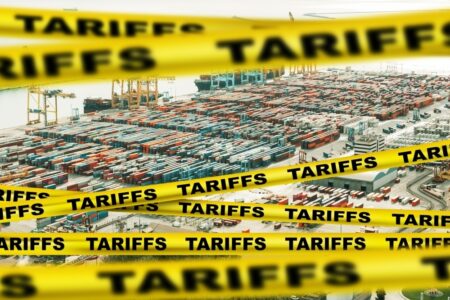In contrast to ‘passive’ funds or trackers, which aim to replicate the performance of an index, ‘active’ funds employ fund managers to try to select the best performing investments.
There are pros and cons for both methods. Passives are cheaper, sometimes substantially so, but they also won’t outperform their index because of charges, however minimal. Meanwhile, finding active fund managers who consistently generate above-average returns over the long term can be tricky.
Many active managers have had a particularly tough time keeping up with passives over the past decade. Some of the best returns globally have come from the very largest companies, notably the so-called Magnificent Seven tech-enabled businesses including Microsoft, Apple and Nvidia, and this has made global and US indices hard to beat.
Active vs. passive returns
Any index that contains the big US tech stocks that have eclipsed the performance of almost everything else over the past decade represents a big hurdle. As a group, active managers generally have less exposure to these heavyweights that have driven the headline indices such as the US S&P 500 or the global MSCI AC World forward.
In contrast, strength in big tech has directly benefitted passive funds. They invest according to the composition of the index which is typically weighted according to company size, so they have ridden the wave of market momentum higher.
Active funds mostly invest according to the manager’s interpretation of merit, rather than size. They tend to invest less in the very largest companies for reasons of diversification and risk management, or because they prefer to pursue opportunities in smaller firms or pursue a ‘value’ strategy where they can be more sure of intrinsic worth. Some active fund managers have outperformed – usually by being more focussed on larger tech stocks – but a significant majority have failed to beat the broader market.
Growth-orientated managers too might eschew the ‘Magnificent Seven’, at least in the same quantity as the index as it brings significant concentration risk to a portfolio. These stocks represent around a third of the US market and a quarter of the global benchmark. It’s unlikely that a fund manager will be bullish on all of them meaning they would naturally own less than the index.
Even if they were positive on these heavyweights owing to their ability to harness the growth of artificial intelligence and other emerging technologies, they would likely prefer to be well diversified by sector, country and individual company for risk management purposes.
Consequently, the Investment Association Global sector only 13% of active funds available to retail investors have outperformed the MSCI AC World (the most common benchmark for funds in the sector) over the past decade. Over shorter periods you would expect things to be better, but it barely improves over five years with only 15% achieving index-beating returns over that period. It’s a similarly bleak picture in the North America sector with only 10% of actively managed funds beating the S&P 500 over ten years, and 16% over five years. Source for data: FE Analytics, to 27/02/2025.
Fallen stars?
There are some high-profile casualties among these numbers. It has recently been reported that popular fund managers Terry Smith and Nick Train saw a combined outflow from their funds of around £5bn over the past year with investors increasingly favouring simple passive products. The two ‘star’ managers have not been able to keep up in a world where the performance of the benchmark has been driven by a small cohort of big stocks.
Mr Smith recently noted that, “outperforming the market was more than usually challenging once again in 2024” in the context that just five stocks Nvidia, Apple, Meta, Microsoft and Amazon provided 45% of the returns of the S&P 500. He has at least had some modest exposure in his Fundsmith Equity Fund. Meta and Microsoft remain holdings, although the latter is a much smaller weight than the index, while a position in Apple was sold during 2024.
The manager draws a clear distinction between these diverse consumer businesses and Nvidia whose microchip demand comes from just a handful of ‘hyperscalers’ building data centres for Artificial Intelligence training. In keeping with an aim of producing “a high likelihood of a satisfactory return rather than the chance of a spectacular return which could be spectacularly good or spectacularly bad” Mr Smith is happy to sit permanently on the Nvidia sidelines.
In the same global sector Lindsell Train Global Equity has underperformed by a more significant degree – partly because it has never owned any of the Magnificent Seven stocks. Manager Nick Train is similarly steadfast in sticking to his long-held investment principles in seeking companies that consistently produce cash and have clear competitive advantages such as strong brands. Typically, his ideas come from areas such consumer goods, financial services, or software and data services.
Neither of these funds are part of the Charles Stanley Direct Preferred List of ideas for new investment. However, their popularity among investors is merited by a highly selective stock picking approach and relatively concentrated portfolios featuring a small number of best ideas. It means mistakes can be punished more severely than with a more diversified fund, but they do provide proper active management with a clear and established process.
These managers can be trusted to avoid short term factors, largely ignore the macro-economic picture, and stick to their knitting of focusing on businesses that meet strict criteria.
Could active managers catch up?
Following a period where passive strategies have performed well and increased in popularity, a fightback from active funds is long overdue. A wobble among the top dog tech stocks could tilt the balance back towards active funds, particularly those taking a contrarian or ‘value’ approach that focuses on cheaper, unfashionable shares. This has started to happen over the past couple of months, though it is a short period, and the trend may not be sustained.
In addition, improved performance from smaller companies would help active funds in most sectors. These have mostly been a drag on returns in recent years. More broadly, a market where winners come from different sectors, or where a wider range of stocks do well, should provide a better backdrop for active managers.
A return of more stock market volatility could also assist the relative returns of active managers. In choppy markets the dispersion of stock returns increases, often accompanied by the mispricing of risk which often provides a more fertile hunting ground. It doesn’t guarantee outperformance, just the range of potential outcomes. To succeed, managers need to have the skill to turn circumstances into performance. Nonetheless, the increasingly unpredictable geopolitical backdrop may favour the more discerning approach taken by differentiated active funds.
Whatever happens it is important for investors to note the top-heavy nature of US and global indices and the increased reliance on a relatively small number of businesses continuing to deliver. These companies are mostly expensively valued in relation to their earnings, so they could also be more vulnerable to any disappointing news surrounding their profitability or outlook. Plus, their weights in market indices means the passive funds dominated by them do not offer quite the same diversification they once did. Their faltering performance this year is a reminder of the need to build resilient portfolios that aren’t simply ‘flying on one engine’.
Active managers tend to earn their stripes over market cycles and not necessarily through an extended bull market where valuations get more stretched. While passive funds should be applauded for increasing the focus on cost, which has rightly put pressure on active funds to demonstrate value for money, concentrating on this alone without being conscious of risk versus return balance can be unhealthy. There is a place for both active and passive funds in a portfolio, which is why we advocate a ‘best of both’ approach when choosing investments.
Nothing on this website should be construed as personal advice based on your circumstances. No news or research item is a personal recommendation to deal.
Will active fund management fight back?
Read this next
Trump's Congress speech moves markets
See more Insights



